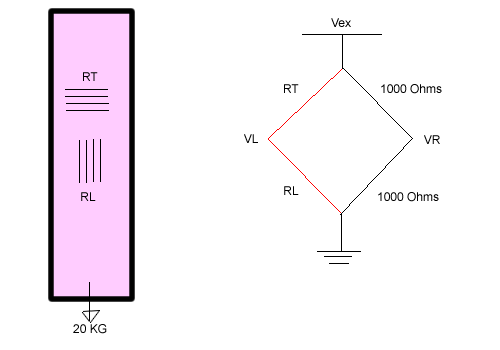Strain Gauge Pop Quiz 2002
Study the strain gauge placements given below and calculate an answer to
the question asked.
This quiz is being given "in class" and you have a 20 minute time
limit.
You are not allowed to collaborate with your teammates.
But you can use any notes you like,
and certain equations will be on the blackboard for your consideration.
During the 20 minutes for the quiz you can go off and log onto the internet,
if you think that will help you.
This page was formatted in Dreamweaver, and unfortunately I did
not have an equation editor available...
name________________________________ answer__________________________volts
Consider a rectanguloid bar of rigid material, 0.49 cm thick, 4 cm wide and
50 cm long.
The length is from the point of attachment of the material from above, where
a "sky hook" holds
the bar vertically above the floor, to the bottom of the 50 cm length where
is suspended
a weight of 20 kg, putting the bar in tension. There is a longitudinal strain
gauge on the front face
of the bar (the wide part), and also on the front face is a transverse-placed
gauge.
The gauges are 350 Ohms, unloaded.
The two strain gauges find their way to one side of a Wheatstone bridge, as
diagrammed below.
The other side of the bridge has a 1000 Ohm resistor in each leg.

An instrumentation amplifier has an output of Vout = 100 x (VL - VR) volts.
Vex is 10 volts.
If there is no load on the bar, Vout is zero volts. Poisson's ratio of the strain
gauge material is 0.5,
but the material of the bar has a lower Poisson's ratio, of 0.25.
Hint: The gauge factor remains 2: dR/R = 2*longitudinal_strain. Calculate
the longitudinal strain!
Your question:
if Young's modulus of the material is 100,000 Newtons/cm-sq (not Pascals,
in m-sq)
what is the voltage output of the amplifier when the material is in tension
with the 20 kg load?
Your quiz will be graded by the next class meeting.
If you figure out the correct answer, your scorecard will be signed;
if not, take the next quiz, to be handed out at the end of the next class.
In case you did everything right expect for a calculation mistake (such as the
sign of Vout)
show your work on this test page.
